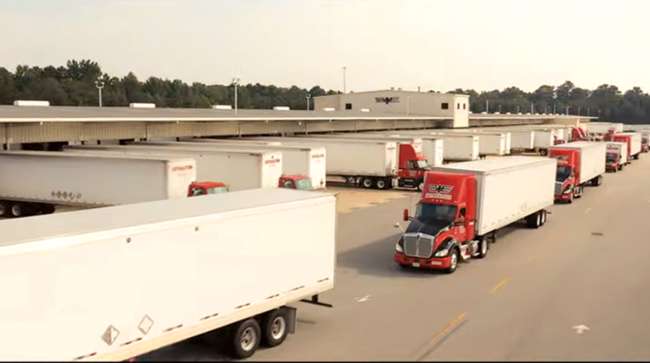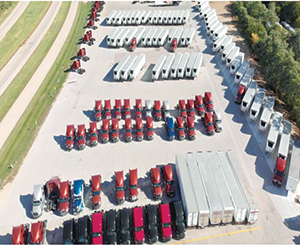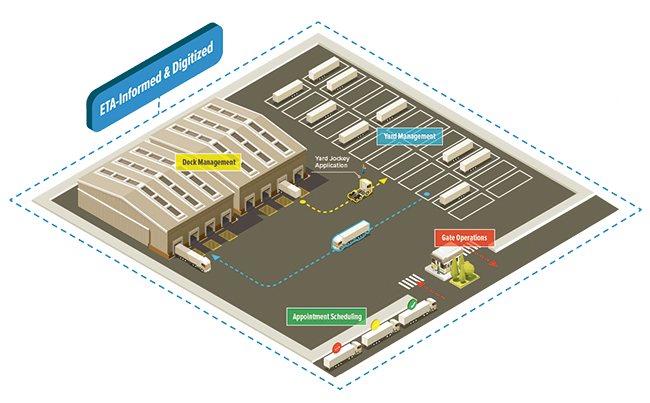Technology Adds Visibility, Efficiency to Yard Operations

[Stay on top of transportation news: Get TTNews in your inbox.]
As the logistics industry moves into the new year, supply chain challenges still remain. Although yard operations serve a critical link, the yard can become a black hole if not managed properly. To meet the challenge, fleets are embracing technology to monitor loads, trailer switches and equipment. Several have developed proprietary yard management systems (YMS) to increase efficiency and manage assets.
Kevin Lage, area vice president of sales for Hirschbach Motor Lines, noted that there is a ton of technology and visibility on its trucks, but the yard can be marred by archaic methods. “Some are still running off of a CB [radio], and there are yards where they have someone driving around in a golf cart or a pickup truck doing a manual count. By the time they are done, it is already out of date,” he said
Hirschbach, which is based in Dubuque, Iowa, and ranks No. 66 on the Transport Topics Top 100 list of the largest for-hire carriers in North America, invested in yard management technology after needing a better solution. Lage said its transportation management system platform — Spot by Hirschbach — has aggressively embraced deploying technology to better manage site operations and improve communication flow with the dock, transportation and scheduling, as well as the third-party carriers. The fleet has developed its own yard management software called Spot Light.
Lage said a YMS allows the yard service provider to have visibility and successfully manage productivity either on-site with local management or at a corporate level. It also improves communication to third-party carrier partners by automatically sending trailer status and inventories to the carrier representative. “It is a massive advantage for carriers to get hourly updates on the status of trailers in the yard,” Lage said.

Although yard operations serve a critical link to supply chain, the yard can become a black hole if not managed properly. (Hirschbach Motor Lines)
Debbie Sackman, senior product manager for the fleets division of SkyBitz, said increased visibility through trailer tracking helps decrease turn times. “In the trailer and container world, it is all about turning that asset around and getting it moving with new cargo for the customer,” she said. “If it comes in loaded, I want to make sure I get it unloaded quickly, and I want to know if it has been unloaded so I can move it out of the way or get it loaded so I can get it moving again.”
Southeastern Freight Lines developed in-house yard management technology to complement its dock operation. “We feel like that integration from the dock to the yard is a natural integration that needs to be there,” said Woody Lovelace, chief information officer at Southeastern Freight Lines, “Good compliance and discipline in all this technology automatically creates additional velocity and therefore capacity.” The Lexington, S.C.-based fleet ranks No. 34 on the TT100.
Continental Express utilizes iPads within its trucks and an in-house app that pulls data from multiple sources, including its transportation management system, electronic logging devices, Orbcomm and FourKites. “We have modified the tar out of every single program you can think of to make it work for us,” said Ronald Koontz, Director of Information Technology at Continental Express. “Everything is so much quicker getting to us. It is unbelievable how much information we can send either to the yard move person or the driver.”
Utilizing Yard Management Systems
K&B Transportation Inc. uses SkyBitz tracking devices on all trailers and geofenced its yards and shippers’ locations. “We can go to SkyBitz and see what we have available anytime,” said Sandy Gruhn, director of sales for K&B Transportation. “Before we had it, you had to wait until the shippers sent us their yard check, or we had to call the shipper and try to get a yard check.”
Gruhn added that planners can pull a map and see which units are there and where they’re located. “You can even zoom down close enough to see if a trailer is at a dock door. That is a real timesaver,” he said, adding that K&B Transportation plans to upgrade the technology so it can see if trailers are loaded or empty. “We’re a refrigerated carrier, so we’re really conscientious about the cost of the assets. A reefer is four times the investment as a dry van trailer, so we want to make sure they’re being used as efficiently as possible.”
Sackman said the first ROI people typically see around yard management is eliminating manual yard checks. “The next piece of that is having more up-to-date, real-time information about where everything is in the yard, in addition to knowing things like load status of what is in the yard,” she said.
Courtland Halbrook, general manager of facilities products at FourKites, said it can be challenging to keep track of trailers and how much free time is allotted to them in big yards. “Having visibility to each individual trailer’s time-in-yard, as well as a view of the inventory inside the trailer, helps companies identify and prioritize either critical items needed or which trailers were leaving free time,” he said.
Leading yard management solutions include Internet of Things devices to track tractors and trailers on-site, handheld devices to manage workflow and an online appointment management system to enable self-service scheduling for carriers and tools to create an autonomous gate, Halbrook said.
“A good YMS will account for that inventory being available, tell a spotter and the WMS where it’s being held, and enable that item to be easily found as needed,” Halbrook explained, adding that carriers prefer to do business with shippers that use a digitized solution for inventory management because they get capacity back quicker and maximize driver productivity.

Yard management systems help monitor tracking and enable warehouse crews to make changes when needed. (FourKites)
Sackman said SkyBitz offers robust data integration capabilities, so shippers can tap into the information as well. “We can segment their ability to see a specific set of trailers, for example,” she said.
Labor shortages and mounting delays in the supply chain have increased the focus on labor management. “Carrier misses can have a ripple effect on facility operations, as an efficient warehouse will pre-stage pallets to be loaded in a trailer arriving in the future,” Halbrook said.
FourKites’ Dynamic Yard solution monitors the truck associated with the appointment to keep track of its ETA, enabling warehouse crews to make changes to schedules that minimize how often they need to restage freight. “The end result is avoiding overtime with your labor pool, maximizing output from the dockworkers you do have, and improving employee retention with tools designed to minimize frustration and wasteful activities,” Halbrook said.
Lage said that as labor challenges have increased, the need for efficiency has increased. “If we’re turning those trailers faster, so there is always an empty trailer at the door, their labor can be more efficient,” Lage said.
Assisting Drivers
Technology can also save drivers time. Doug Schrier, senior vice president of strategy at Transflo, said the key is getting people, especially drivers, the information they need. Its Mobile+ app connects with yard management systems and other management software to bring visibility, communication and data together for drivers.
“We’re trying to connect the shipper with the carrier and the professional driver. Plus, in a lot of freight today you have a broker, and you have to connect all four," he said. “If you make it seamless for the driver, it becomes a shipper or receiver of choice in the driver’s eyes,” Schrier said, adding that every minute counts. “If a driver doesn’t want to go pick up a load at a supplier, ultimately the shipper has to pay higher rates because of it.”

In this special 2021 Roundabout episode, host Mike Freeze looks back at how trucking not only worked to recover from the effects of the pandemic, but also improve through the darkest of times. Hear a snippet above, and get the full program by going to RoadSigns.TTNews.com.
Spot by Hirschbach takes advantage of data to reduce the average cycle time by looking for events that cause slowdowns.
“In Kansas, we took the cycle time that was 40 minutes and got it down to 12 minutes. We’re part of the solution, giving them information to help them be better inside,” said Paul Ruiz, director of operations and analysis for Hirschbach. “When we have long cycle times, we’ll say we failed here, here’s why, and here is our action plan.”
The need for increased speed can put a strain on employees, and Lovelace said technology has played an essential role to absorb the stress and provide good customer service. “It can tell us the number of people in the yard — hostlers — we need. We don’t have people out there sitting idle waiting for the next surge,” he said.
For operators, driver staffing within the yard is a growing challenge. “In the past 18 months, as the driver shortage has gotten worse, wages have gone up, rates have gone up, and we’ve seen drivers that are working in spotting operations jump ship and go over the road because they can make more money,” Lage said, adding that some yards have better conditions than others. “That can make a big impact on us when it comes to keeping drivers and operating properly.”
Gruhn said good communication improves yard management and he would like to have even more information. “As a carrier, we’d like to have a FourKites type application for being able to track activity at a shipper, so we could go into a website or get updates that would show the status of each trailer or get regular updates or to get any type of proactive information,” he said.
When it comes to implementing a yard management system, Ben Wiesen, president of Carrier Logistics Inc., said the most successful implementations clearly define standard operating procedures, so all staff understands expectations and how to execute best practices. “No matter how good the software, if users don’t have proper training, if management doesn’t enforce that the application be used, and if careful planning isn’t undertaken, the results are likely to disappoint,” he said.
Want more news? Listen to today's daily briefing below or go here for more info:

